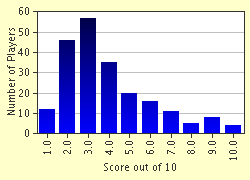Quiz Answer Key and Fun Facts
1. Who brought Christianity to Scotland?
2. What was the first capital of the Scots?
3. The first monument of an American president outside the USA can be found in Edinburgh and the president is:
4. This Scottish city is also known as the City of Roses:
5. Which of the cities located near the borders region officially remained at war with Russia for from 1856-1966?
6. Scottish Lords of the Isles were members of which clan?
7. The legend has it that the wizard Merlin is buried in which Scottish village?
8. In this town you could find in the sixteenth century two universities - exactly the same number of universities could be found in the whole of England at that time. Which city wass it?
9. The legend has it that Robert Bruce waged his war inspired by which of these?
10. Who is Edinburgh's Princes' Street named after?
Source: Author
gacia
This quiz was reviewed by FunTrivia editor
bloomsby before going online.
Any errors found in FunTrivia content are routinely corrected through our feedback system.


